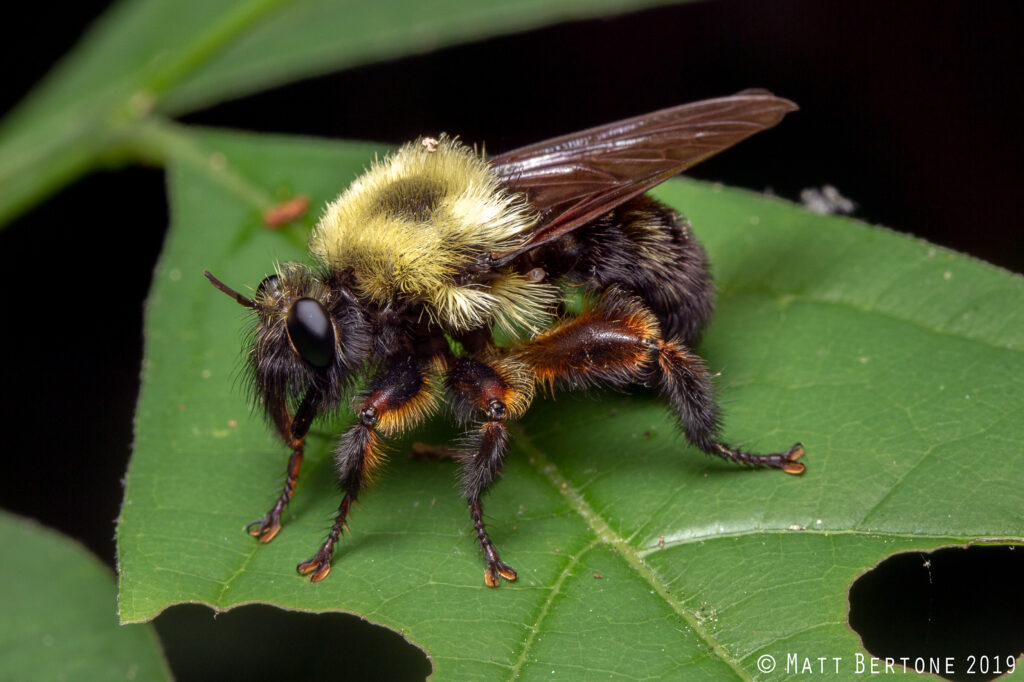Guide to Identifying Common Home and Garden Stinging Pests
go.ncsu.edu/readext?1021670
en Español / em Português
El inglés es el idioma de control de esta página. En la medida en que haya algún conflicto entre la traducción al inglés y la traducción, el inglés prevalece.
Al hacer clic en el enlace de traducción se activa un servicio de traducción gratuito para convertir la página al español. Al igual que con cualquier traducción por Internet, la conversión no es sensible al contexto y puede que no traduzca el texto en su significado original. NC State Extension no garantiza la exactitud del texto traducido. Por favor, tenga en cuenta que algunas aplicaciones y/o servicios pueden no funcionar como se espera cuando se traducen.
Português
Inglês é o idioma de controle desta página. Na medida que haja algum conflito entre o texto original em Inglês e a tradução, o Inglês prevalece.
Ao clicar no link de tradução, um serviço gratuito de tradução será ativado para converter a página para o Português. Como em qualquer tradução pela internet, a conversão não é sensivel ao contexto e pode não ocorrer a tradução para o significado orginal. O serviço de Extensão da Carolina do Norte (NC State Extension) não garante a exatidão do texto traduzido. Por favor, observe que algumas funções ou serviços podem não funcionar como esperado após a tradução.
English
English is the controlling language of this page. To the extent there is any conflict between the English text and the translation, English controls.
Clicking on the translation link activates a free translation service to convert the page to Spanish. As with any Internet translation, the conversion is not context-sensitive and may not translate the text to its original meaning. NC State Extension does not guarantee the accuracy of the translated text. Please note that some applications and/or services may not function as expected when translated.
Collapse ▲The use and enjoyment of your lawn or garden can be hindered by even the thought of a stinging pest buzzing by. Many pests can be controlled or deterred from nesting in particular areas but proper identification is crucial. Continue reading for the most common flying pests found in the lawn, garden, and landscape that are mistaken for honey bees.
The first step in stinging pest identification is determining whether what you’re dealing with is a bee, wasp, or fly. This will help you narrow down what the insect is and allow you to better be able to find the resources you need for control measures. Here are a few anatomical differences to look for between the different insects.
Bees: Members of this group often have hairs all over their bodies, many of which are branched. They frequently have a “fuzzy” appearance. Bees also have what are referred to colloquially as pollen baskets. These are structures or long hairs found on their hind legs or under their abdomen that bees use to store pollen between flowers.
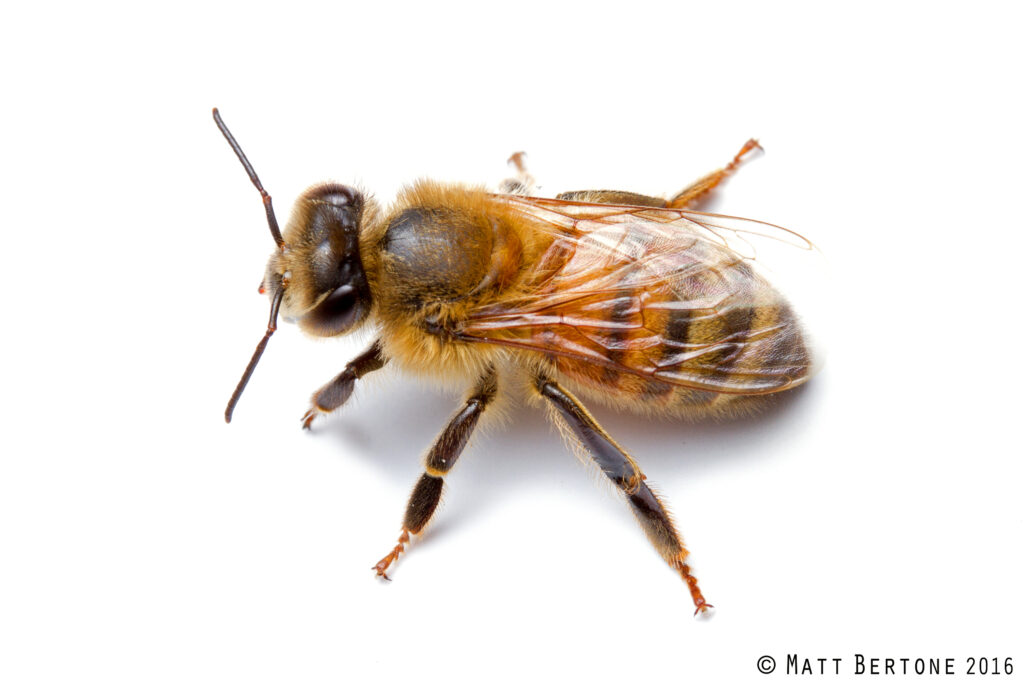
Pictured Above: Honey bee, notice 2 pairs of wings, hairs all over their body.
Wasps: Members of this group lack the complex branched hairs that bees have. They do however have hairs on their body that are often straight, but usually not as abundant as those found on members of the bee family. While this is a great way to identify these pests, it’s not perfect because there are many exceptions. Another anatomical feature of wasps is their very narrow waist (formally referred to as a petiole). While not all species of wasps will have a very distinctive skinny waist, it is narrow in all members of this group.
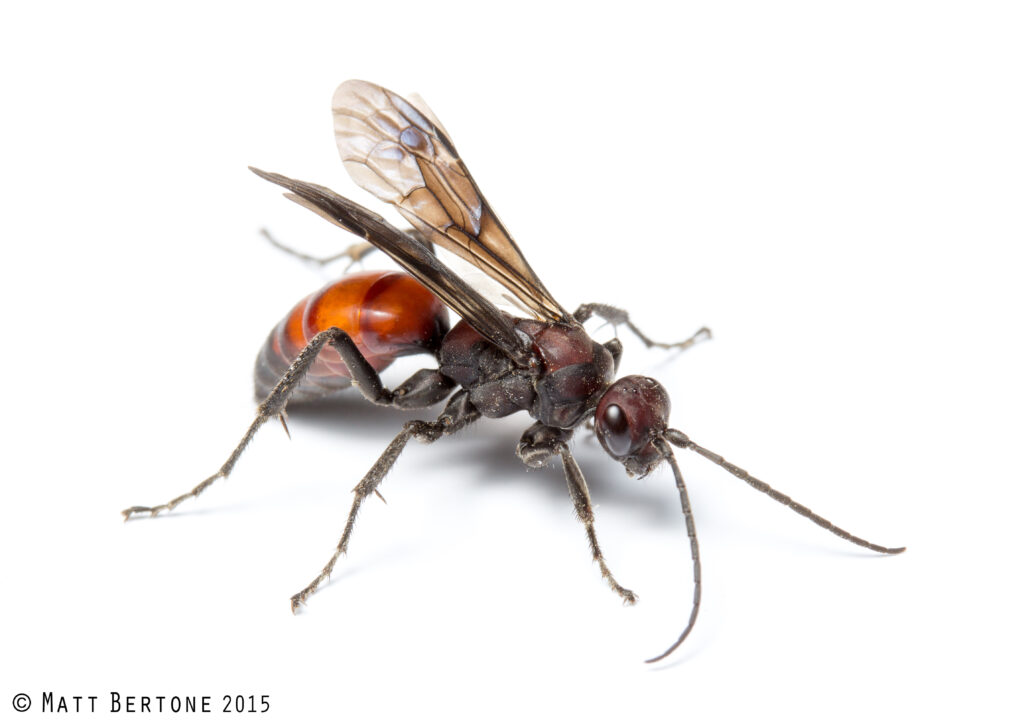
Pictured above: Spider Wasp, notice 2 pairs of wings, skinny waist, and lack of an abundance of hairs.
Flies: Members of this group are distinct from wasps and bees because they only have two wings. Wasps and bees will both have a total of four. Diptera, the order to which all flies belong, is Greek for “two wings” (di and pteron, respectively). Some flies have evolved into near-perfect mimics of their bee and wasp counterparts to gain protection. Looking for one pair of wings is the easiest way to differentiate these mimics from their counterparts. Flies do not have stingers and only robber flies (Asilidae) can potentially bite in defense. Continue reading below to see a few of the flies commonly mistaken for bees or wasps.
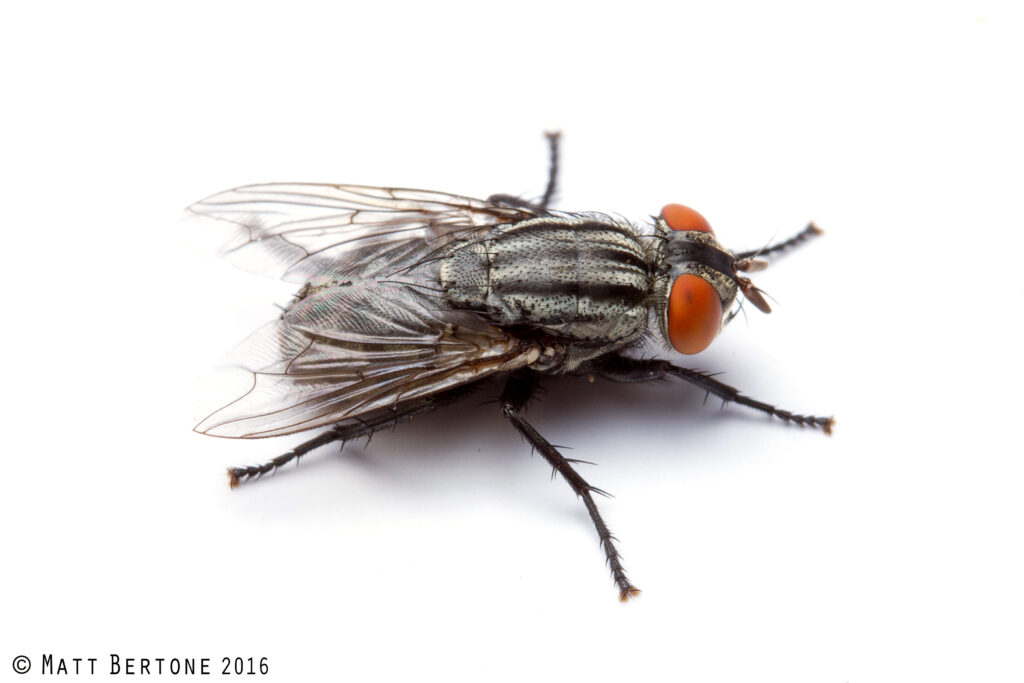
Pictured above: Flesh Fly, notice one pair of wings and lack of stinger on abdomen.
Wasps: Remember, members of this group have 2 pairs of wings (4 total), a thin waist, and few fine hairs.
Yellowjackets
Yellowjackets are commonly mistaken for honey bees but are considered wasps. Like many other wasps, yellowjackets hunt other insects for their young rather than primarily nectar and pollen. Yellowjackets commonly nest in the ground but may choose to take residence in other voids such as attics, storage buildings, or voids in houses. I’ve even found them (the hard way) nesting in loosely bound haybales!
Yellowjackets are known for their aggressive nature and their propensity to sting. Their likelihood of stinging someone increases as you get closer to a nest. This means if you’ve been stung, the nest is likely close by. The nest is often underground but can be aerial. Yellowjackets use chewed wood material to build a “paper” nest. Common places nests are found are in the eaves of houses, gardens, pastures, sheds, and barns.
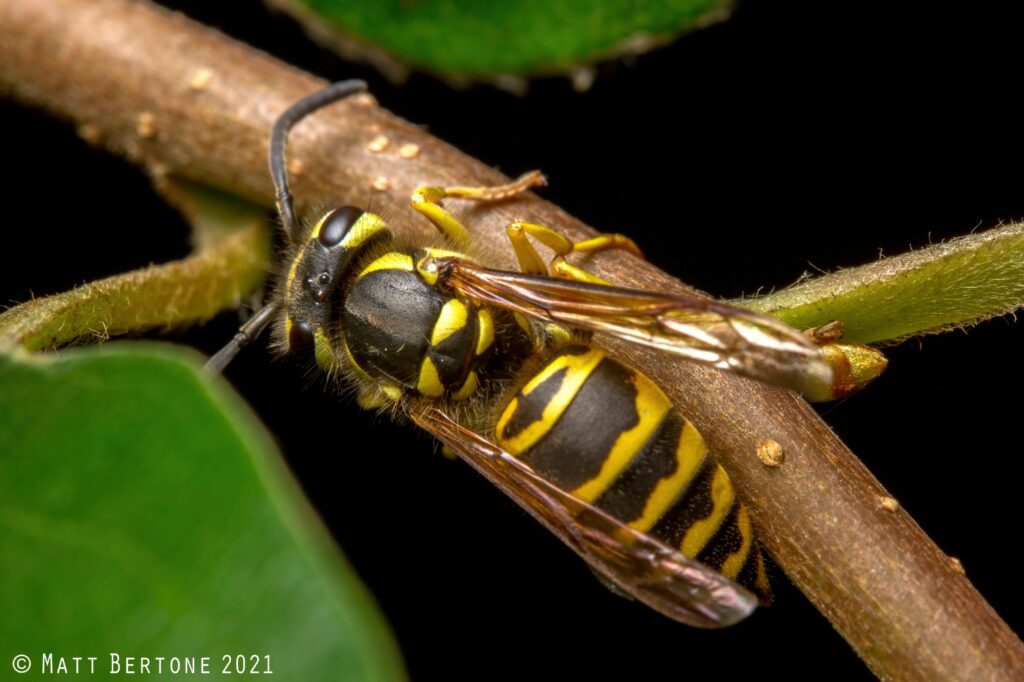
Bald-Faced Hornet (sometimes called “aerial yellowjacket”)
These insects belong to the Vespidae family and are very similar in behavior and biology to yellowjackets. Bald-faced hornets often build nests in trees and sometimes even roof peaks. Like yellowjackets, they are very protective of their nests and will sting if you’re nearby and they feel threatened.
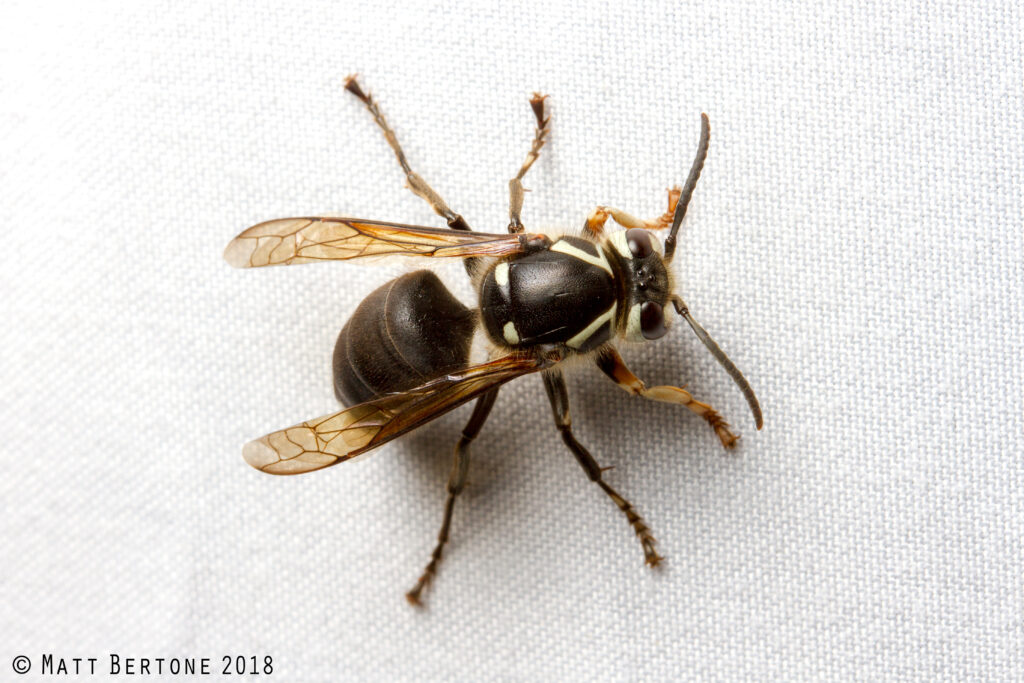

Image: Ryan Hodnett, CC-BY-4.0
Paper Wasps
These wasps are less aggressive than yellowjackets and bald-faced hornets and will typically only sting if provoked. They commonly build their small, open, single-tiered papery nests in covered areas such as shelters, inside pipes, porches, house eaves, etc.
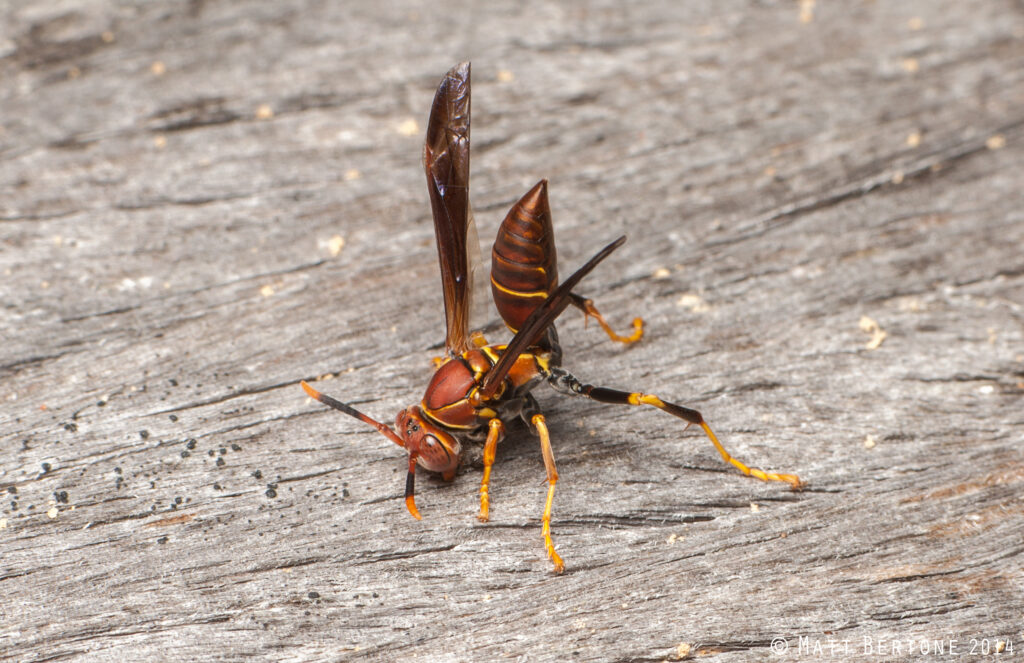
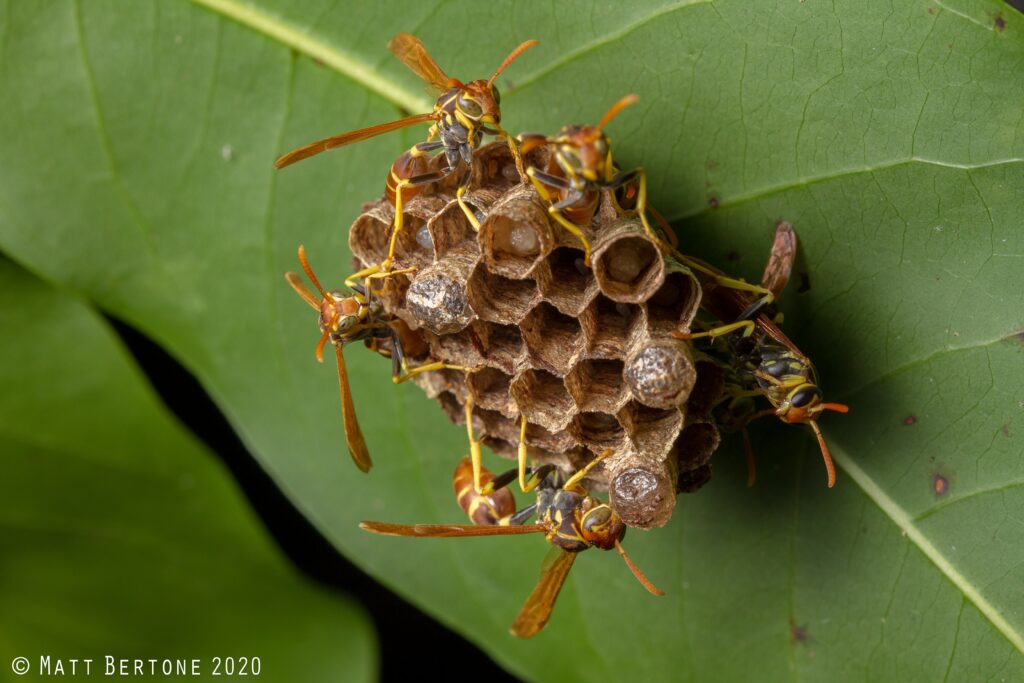
Cicada Killer Wasp
As their name implies, cicada killer wasps can be observed paralyzing cicadas and returning to their nest with their prey. They then prepare their nest with the cicada as a food source for developing larvae to feed upon. Children and pets may feel intimidated because they fly at 24-36” off the ground. Despite being aggressive, low flyers, cicada killers are not aggressive and are unlikely to sting (unless severely provoked, eg. being grabbed). Even then, despite their large size, stings are said to be mild.
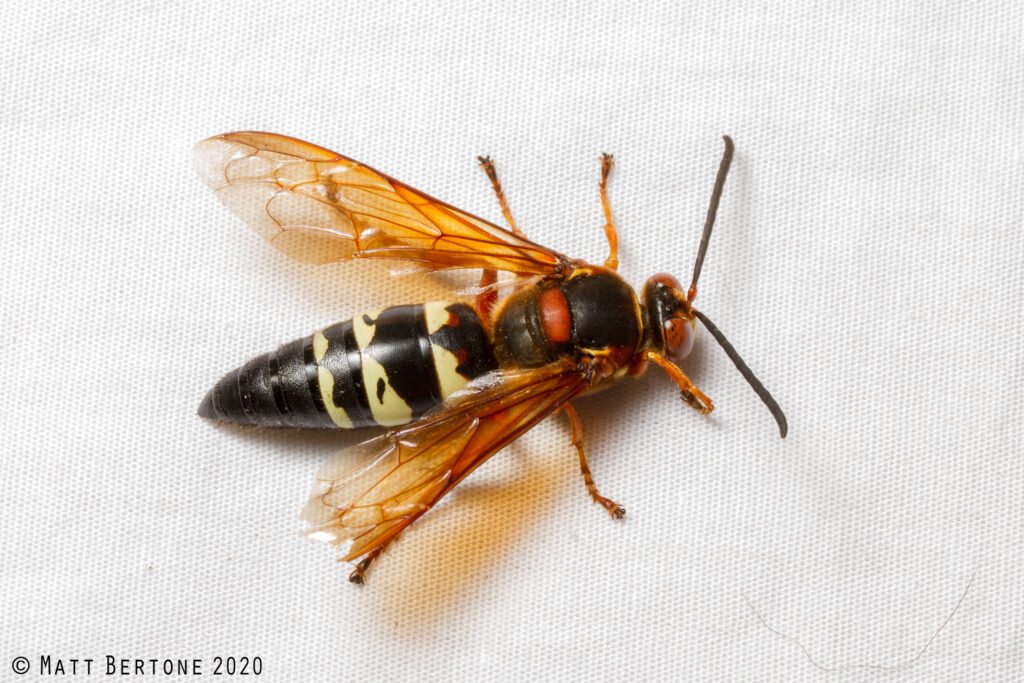
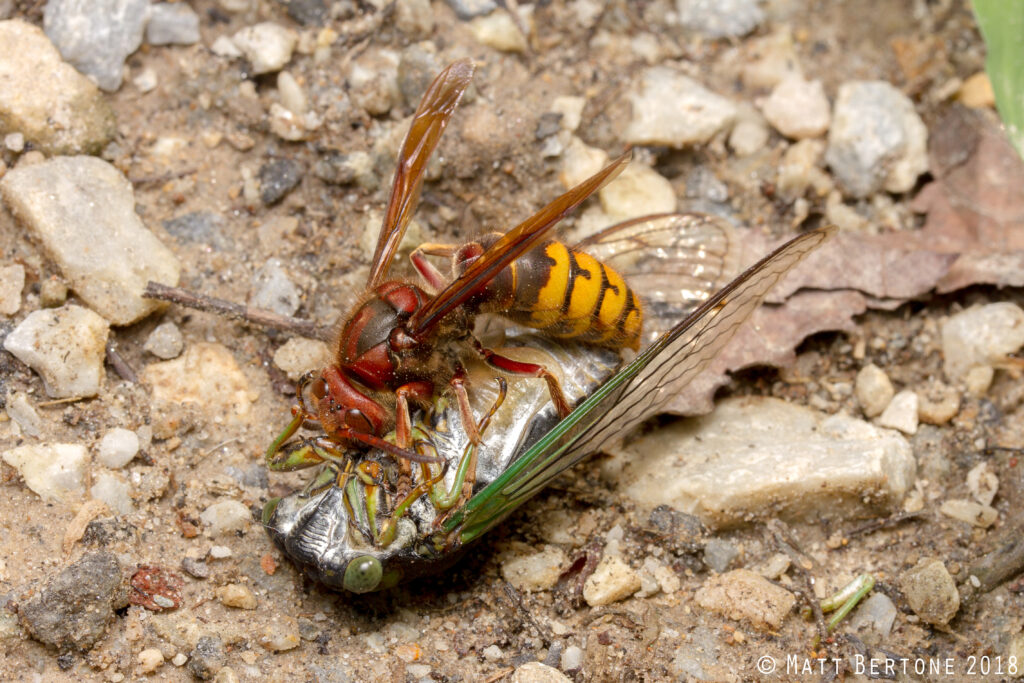
Bees: Remember, members of this group have 2 pairs of wings (4 total) and are “fuzzy” because of their complex branched hairs, and often have long hairs on their hind pair of legs or under their abdomen (pollen baskets).
Honey Bees:
Honey bees are colloquially referred to as “bees” and this tends to be a source of confusion. Like most species in this article, they’ll typically only sting when provoked. Unlike most bees and wasps, honey bees die after a successful sting, as the stinger sticks in the skin and pulls out the bee’s insides. Many honey bees encountered are foragers visiting flowers from a colony that may be domesticated. Honey bees are not native to North America and were originally introduced as a gift to the American colonies in the 1600s. They’re easily identified by their dull yellow or orange body with black stripes.
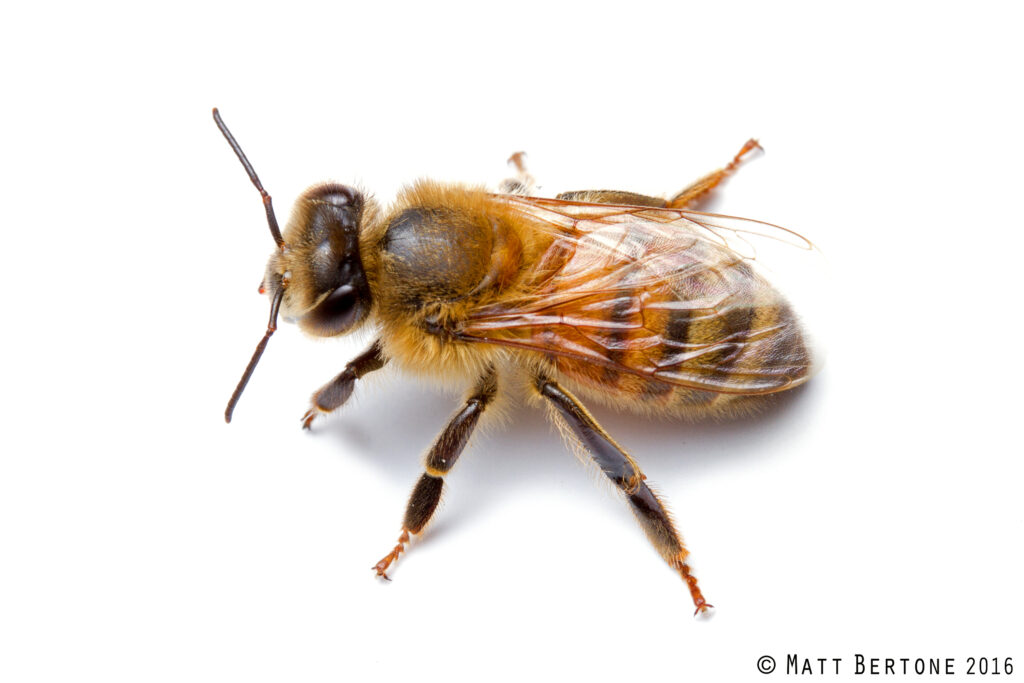
Bumble Bees:
Another common type of bee found is the bumble bee. They’re much larger than a honey bee and nest in the ground or bord boxes in much smaller colonies. An average colony of bumble bees is around 50-400 individuals. Bumble bees pose less risk of stinging when found away from their nest and, like many others on this list, will only sting if provoked. A good way to tell you have found a bumblebee is if it’s approximately 1” long and has a very fuzzy abdomen (rear section). Some people even say they look so large they shouldn’t be able to fly!
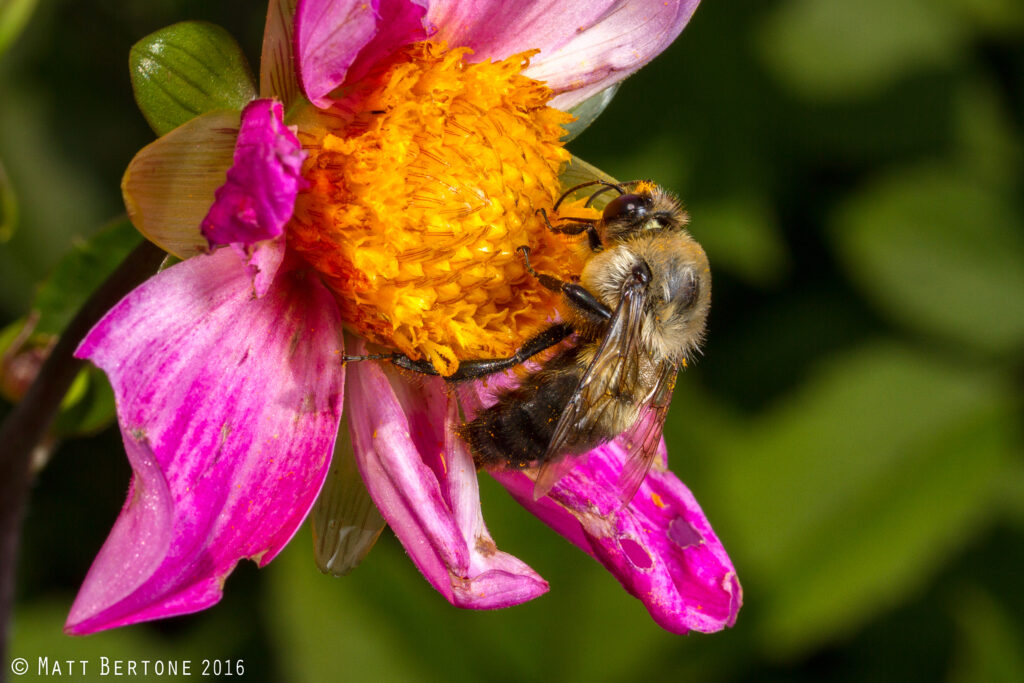
Carpenter Bees:
Carpenter bees are solitary insects, meaning they live by themselves instead of in colonies with complex social structures. These are common pests people deal with because they tend to “drill” holes in wooden structures. They prefer wood that is 2”+ in thickness and use the tunnels to raise their young. Most often, people notice the male carpenter bees because they “bluff” and will aggressively fly up to people but cannot sting because they don’t even have a stinger! One easy way to tell male and female carpenter bees apart is that males have a yellow spot on the face, while females have an entirely black face. Carpenter bees are commonly mistaken for bumblebees, but one key difference is that carpenter bees lack hairs on their abdomen that make them appear as fuzzy as a bumblebee.

Image: JMK, CC-BY 3.0
Mason bee:
Mason bees are busy bees that are terrific pollinators. They are most often confused with the honey bee but are much darker in color. Instead of shades of brown like those found on honeybees, mason bees are darker and often described as black. They’re also slightly smaller than honey bees and are solitary bees, meaning they do not form complex social structures. They’re often much less aggressive than a “tame” honey bee and will only sting if provoked. These insects provide a lot of pollination services, especially during times when honey bees are not as active such as during cooler or rainy weather.

Image: llona L., Flickr
Flies: Remember, members of this group will only have 1 set of wings and lack stingers. All the flies listed below are mimics of bees or wasps so they may look alarming – the exact goal of the Batesian mimicry which is to look harmful without being harmful.
Hover Flies:
Hover flies are poster children for Batesian mimicry, meaning they look like something that can sting or cause harm but are harmless to humans. They’re often mistaken for wasps (especially yellowjackets) which is their goal. These can be positively identified by their large compound eyes, short antennae, and their lack of the wasp waist – though some can be very tricky or convincing mimics! They’re often found feeding on the nectar of flowers alongside other pollinators.
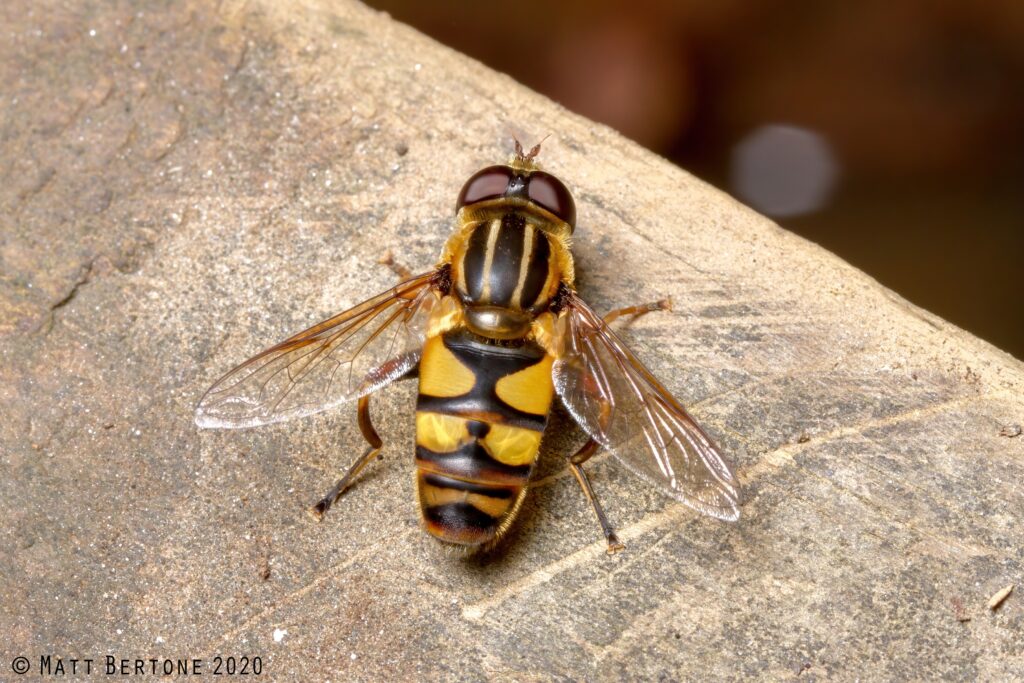
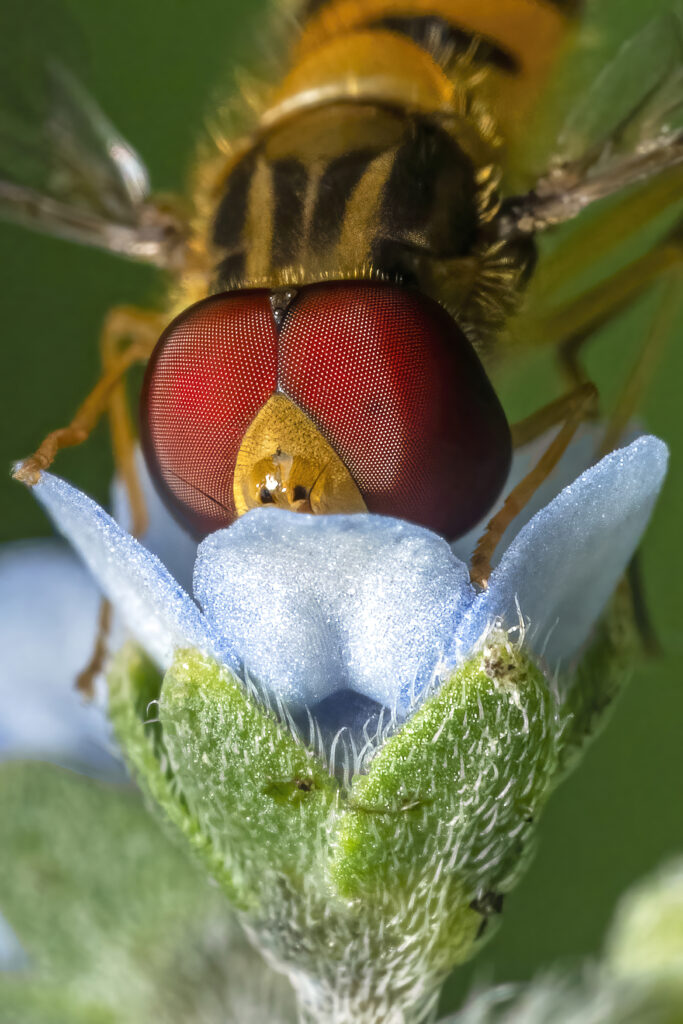
Image: Prasan Shrestha, CC-BY 4.0
Bee Flies:
Another master of mimicry, bee flies (Bombyliidae) use their appearance to come close to solitary bees where they lay their eggs which hatch and parasitize their hosts. This very interesting lifecycle is the reason they’ve developed into mimics of other bees. They do not bite or sting and are most interested in visiting the next flower they have in mind. They normally have a very long proboscis, one pair of wings, and are hairy. They also typically will have a very large abdomen.
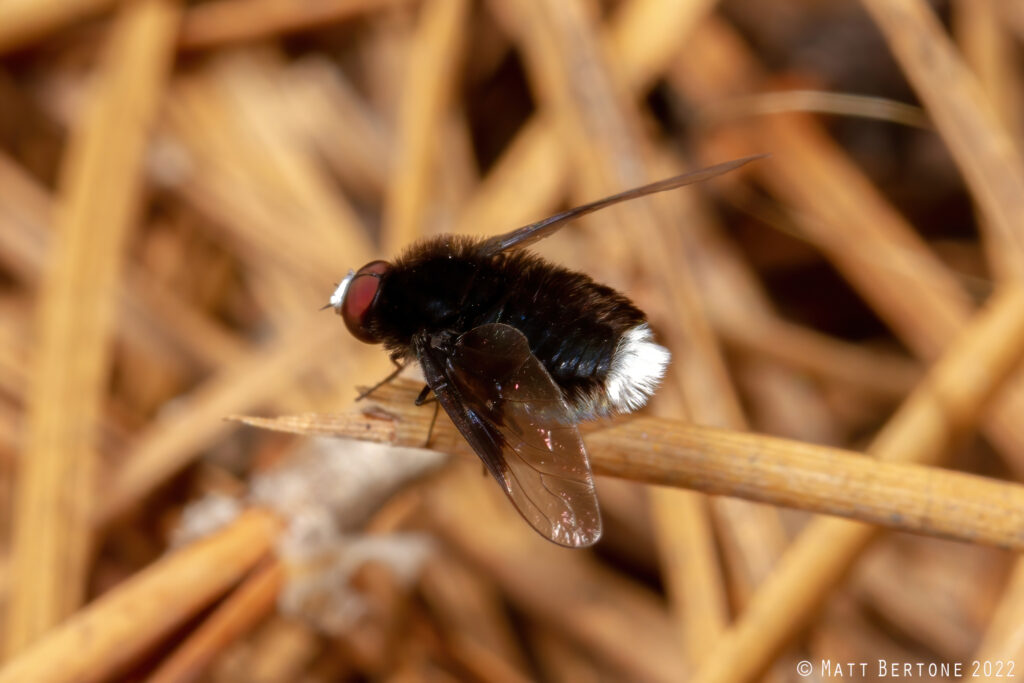
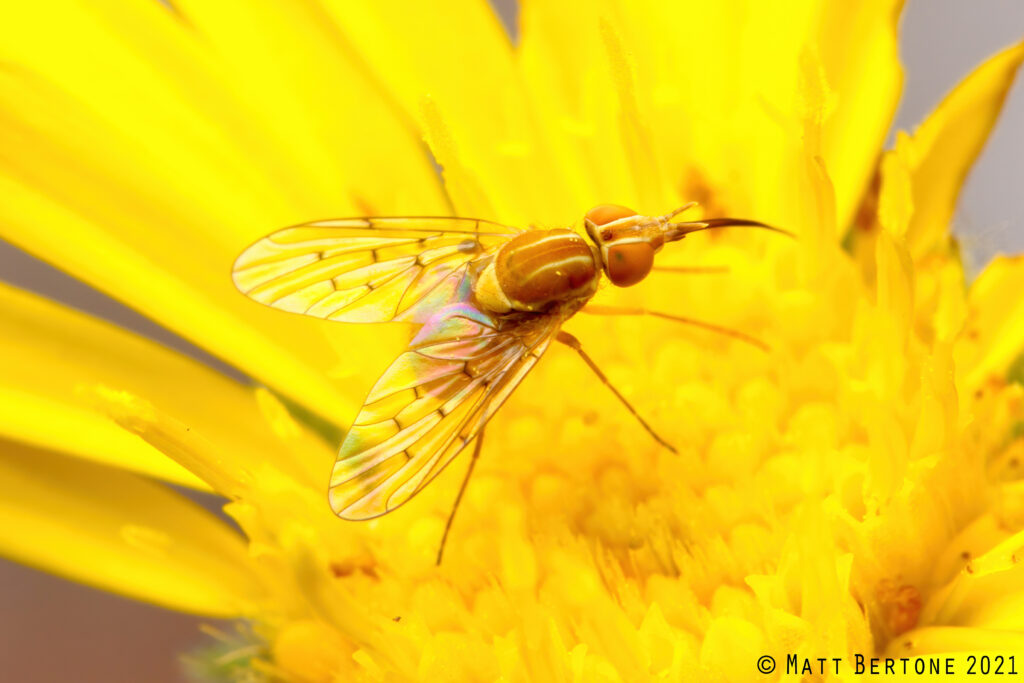
Robber Flies
Robber flies are commonly mistaken for an insect that can sting or cause harm because of their large appearance and mimicry. Like with hover flies and bee flies there’s some variety in this group. They’re often mistaken for horseflies which can add to the confusion. One way to tell these apart from other insects on this list is by looking for the concaved face between the eyes and a “beard” on their face. They can bite, but usually will not unless mishandled.
